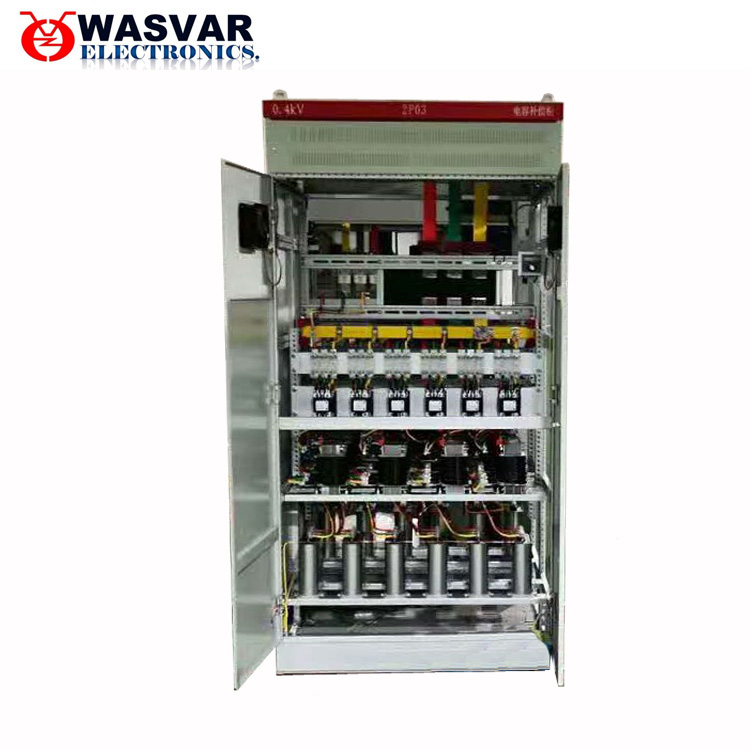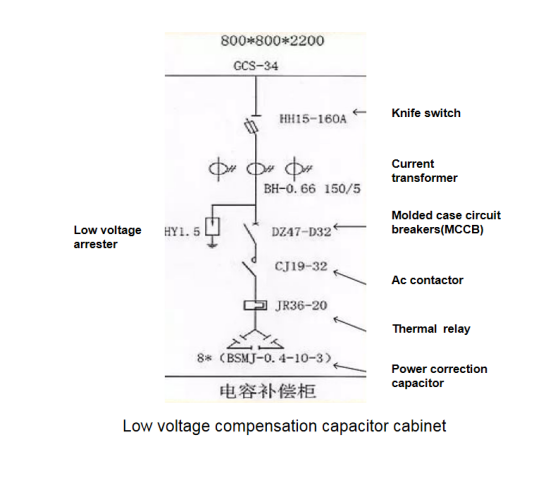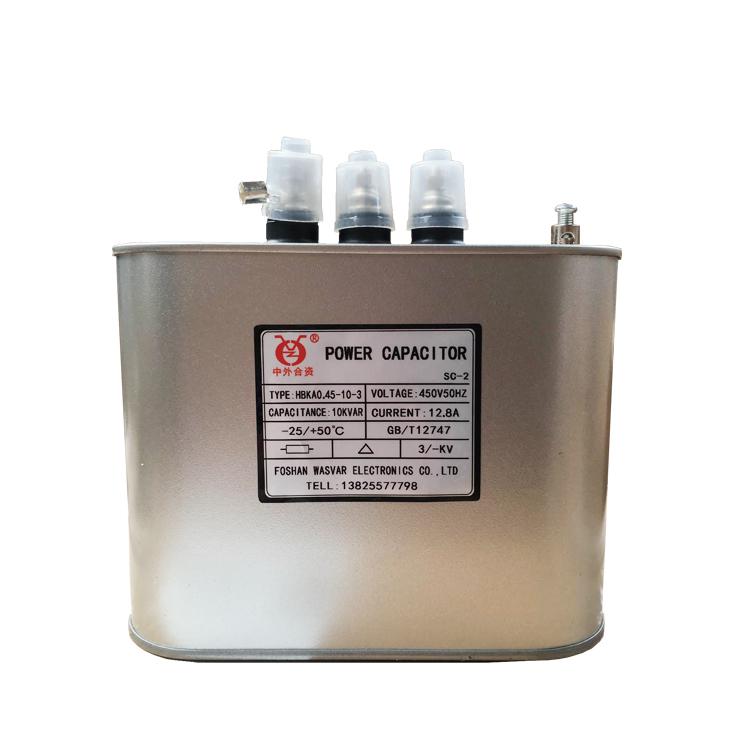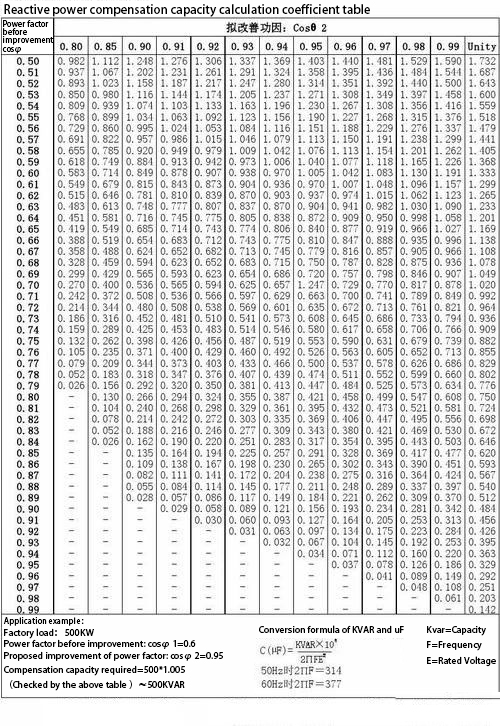What is reactive power compensation and why is it necessary? How much compensation is appropriate?
Date:2020-10-19
We can often see low voltage capacitor cabinet or compensation cabinet, or high voltage capacitor in the power distribution room, I believe readers are not strange.

The capacitor cabinet installed on the side of the high voltage cabinet is called high voltage centralized compensation;Those installed on the low-pressure side are called low-pressure local compensation, and most of them are basically low-pressure local compensation.So what exactly do they do?What is the principle?
(1)A simulation of a capacitor cabinet

Above is a common low-voltage capacitor cabinet simulation diagram. From the figure we can see that the low-voltage capacitor cabinet is connected in parallel on the low-voltage bus. The low-voltage capacitor cabinet in the picture has 8 groups of compensation capacitors. The internal components of the low-voltage capacitor cabinet include: knife switch, current transformer, circuit breaker, AC contactor, thermal relay, compensation capacitor, low-voltage arrester, etc. The high-voltage capacitors cabinet are similar, but the internal components are all replaced with corresponding high-voltage grades. The overall look is much larger than the low-voltage capacitor cabinet. Nowadays, there are no thermal relays in many capacitor cabinets. Instead of thermal relays, a small reactor is used to suppress the sudden change of line current and harmonics, thereby protecting the compensation capacitors at the end. The model of the compensation capacitor in the figure is "BSMJ-0.4-10-3", where the number 10 means that a single compensation capacitor can provide reactive power with a rated capacity of 10kvar. If all 8 groups are put into use, the low-voltage capacitor cabinet can provide a total of 80kvar.

This is a common low voltage compensation capacitor. (Common low voltage capacitor)
(2)What is reactive power and why is reactive power compensation?
Reactive power is the power that has only been converted into the form of electrical energy, not consumed. We all know that electrical equipment has three properties: resistive, capacitive, and inductive. Resistance is well understood. In the form of resistance, current passes through resistive components and is consumed. For example, a hair dryer heats the air blown out by a resistance wire, so that electrical energy is converted into heat.
Capacitive and emotional are different. Capacitive, such as a capacitor, only stores electrical energy and can be released when needed; inductive, such as a reactor, converts electrical energy into a magnetic field for storage, and can also be released. Therefore, in a sense, they do not do work, so they are called "reactive power".
However, reactive power is not useless work, it is actually the foundation of industry. Without reactive power, only the active power generated by resistive components would not be able to establish today's industrial prosperity. Most commonly, the motor needs to establish and maintain a rotating magnetic field to make the rotor rotate, thereby driving mechanical movement. The rotor magnetic field of the motor is established by obtaining reactive power from the power supply. The transformer also needs reactive power to make the primary coil of the transformer generate a magnetic field and induce a voltage in the secondary coil.
Therefore, without reactive power, the motor will not rotate, the transformer cannot transform, and the AC contactor will not pull in.
1) If the electrical equipment does not have enough reactive power to establish a normal electromagnetic field, these electrical equipment cannot be maintained under rated conditions, and the terminal voltage of the electrical equipment will drop, thereby affecting the normal operation of the electrical equipment.
2) If the electrical equipment does not have enough reactive power and requires reactive power from the grid, it will increase the loss of the grid and increase the voltage drop of the line, thus affecting the normal operation of the entire grid. Therefore, basically there will be a capacitor compensation cabinet in the power distribution room for on-site compensation; and the power supply company generally requires the power factor of capacitor compensation to reach 0.9 or more.
Of course, the power supply company does not allow too much reactive power to be transmitted to the grid, because this will cause the line voltage to rise. Therefore, the capacitor compensation cabinet generally has a switching switch, and when it is switched to the "automatic" position, the required number of capacitors can be input according to the actual situation.
(3)How much capacitance compensation is appropriate?
Take a 500kVA transformer as an example. Generally speaking, the reactive power compensation capacity of a distribution transformer is about 20% to 40% of the transformer capacity. Generally, designers use 30% to estimate that 150Kvar is selected as the maximum compensation capacity. Is the installed capacity.
The following is the reactive power compensation scheme for a 500kVA transformer: 1) Reactive power compensation capacity: 150kvar 3×40kvar(20kvar 20kvar) 1×30kvar(20kvar 10kvar)
2) Number of smart capacitors:3*HZC/450-40(20+20) 1*HZC/450-30(20+10)
If there are motors, frequency converters and other equipment, the reactive power compensation algorithm is somewhat different from the transformer algorithm.
The required reactive power compensation capacity can also be calculated by comparing the power factors before and after compensation, for example:
1) The active power of a factory is 600KW, the reactive power is 800Kvar, the apparent power is 1000KVA, and the corresponding power factor is 600/ 1000=0.6.
2) Query the calculation coefficient table of reactive power compensation capacity, and find the corresponding coefficient F before and after compensation. For example, it is 0.6 before compensation, and if you want to reach 0.95 after compensation, you can find the coefficient F=1.0053)
3)and then pass the calculation formula: active power * coefficient F, which is equal to the total amount of reactive power that needs to be compensated. 600*1.005=605kvar.
4) According to the actual situation, some margin can be appropriately enlarged to prevent insufficient reactive power after adding equipment.

Reactive power compensation capacity calculation coefficient table

